Many coffee lovers using Keurig machines often wonder if they can put milk directly into their Keurig to create creamy, milky coffee drinks.
The convenience of a Keurig is enticing, but it’s essential to understand how Keurig machines work to prevent causing harm to your machine or brewing unsatisfactory coffee. Can you put milk in a Keurig?
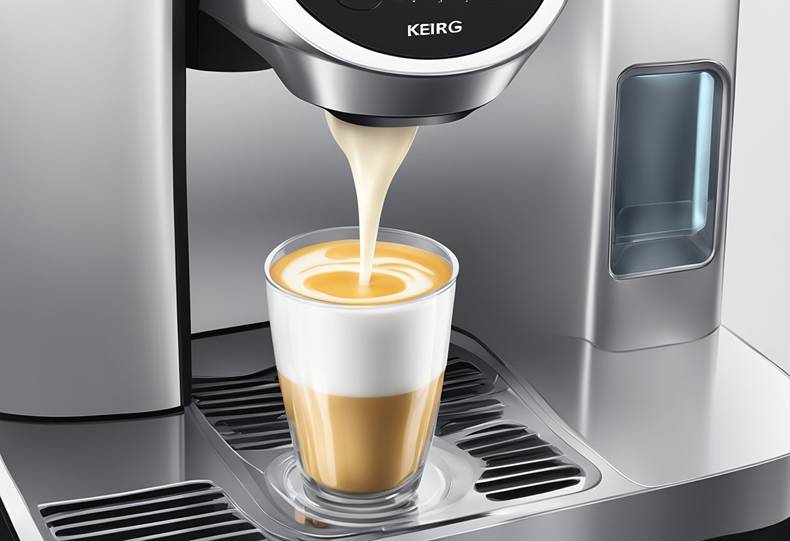
Keurig machines are designed to use water and K-cups to create various coffee beverages. Adding milk to a Keurig can potentially damage the brewing process and reduce the lifespan of your machine.
This means it’s crucial to find alternative ways to achieve milky coffee drinks without risking harm to your beloved Keurig.
Key Takeaways
- It is not recommended to put milk directly in a Keurig due to potential harm to the machine.
- Alternative methods such as using milk frothers and K-cups with froth packets can help create coffee drinks. based on milk
- Keeping your Keurig clean after using milk-related products will ensure its longevity and quality of the coffee.
Understanding Keurig Machines

Keurig machines have gained popularity due to their convenience and ability to quickly brew a single cup of coffee.
These machines utilize a built-in water reservoir that holds water and heats it to the optimal temperature.
Once the water is heated, it is then pumped through a K-Cup that contains the coffee grounds, resulting in your desired cup of coffee.
There are a few essential aspects of Keurig machines that you should be aware of:
K-Cups: These are small, pre-packaged pods filled with coffee grounds, tea leaves, or cocoa. To make your beverage, simply place the K-Cup into the machine and press the appropriate button.
Water Reservoir: The reservoir holds water necessary for brewing. Make sure to fill it up before using the machine, and only use filtered or purified water to prevent mineral buildup and potential clogs.
Button Controls: Keurig machines come with user-friendly button controls. These buttons typically include options for selecting the desired size of your beverage and brewing your drink. Familiarize yourself with the control panel to ensure you’re getting the perfect cup of coffee every time.
It is important to note that Keurig machines are specifically designed to handle water, not milk or other liquids.
This is because the machine’s mechanism heats and pumps water through the coffee grounds, and it is not built to handle the thickness and consistency of milk.
Moreover, using milk in the water reservoir could cause clogs and damage to your machine.
Therefore, if you’re looking to prepare a milky coffee or latte, follow the appropriate alternative methods to obtain the desired results without jeopardizing the functionality of your Keurig machine.
Can You Put Milk in a Keurig?
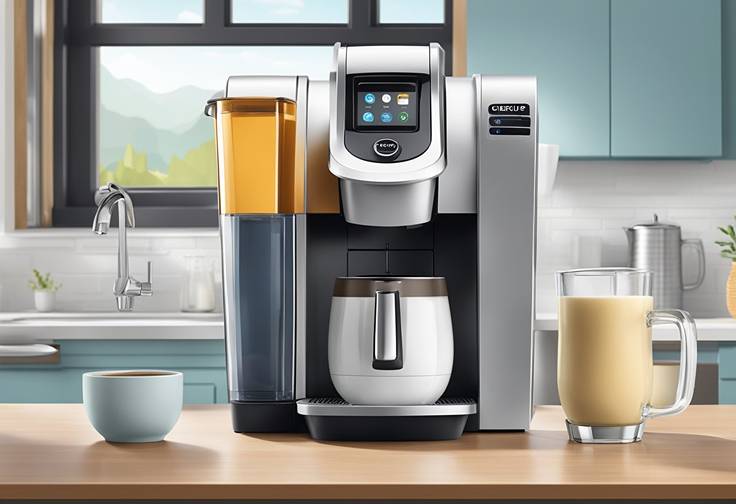
As a coffee lover, you might be wondering if it’s possible to add milk directly to your Keurig machine.
The confident, knowledgeable, and clear answer to this question is a resounding no!
There are several reasons why putting milk in your Keurig is not recommended.
First and foremost, the Keurig is specifically designed to heat and pump water through coffee grounds, not to handle the thickness and consistency of milk.
The texture of milk can cause damage to your machine, as its delicate internal components are not constructed for liquids denser than water.
Furthermore, milk can also alter the flavor of your coffee, making it taste less than optimal.
There are also hygiene concerns when adding milk directly to your Keurig’s water reservoir.
Milk residue can accumulate inside the machine, leading to a potential buildup of bacteria.
This not only affects your overall coffee experience but also poses potential health risks.
If you’re looking to enhance your coffee with the delicious creaminess of milk, there are several alternative methods:
- Add milk manually: Pour warm or frothed milk into your coffee cup after brewing your coffee with the Keurig machine.
- Use milk-based K-Cups: Some K-Cups come with milk powder or creamer included, which adds the desired dairy element to your coffee without damaging the Keurig.
- Invest in a milk frother: Purchase a standalone milk frother to create lattes, cappuccinos, and other milk-based drinks with Keurig brewed coffee.
In conclusion, while it may be tempting to put milk directly into your Keurig, doing so can damage the machine, create unpalatable flavors, and cause health concerns.
Stick to adding milk separately or using suitable milk alternatives to protect your Keurig and enjoy the perfect cup of coffee every time.
Impact of Milk on Keurig Machines
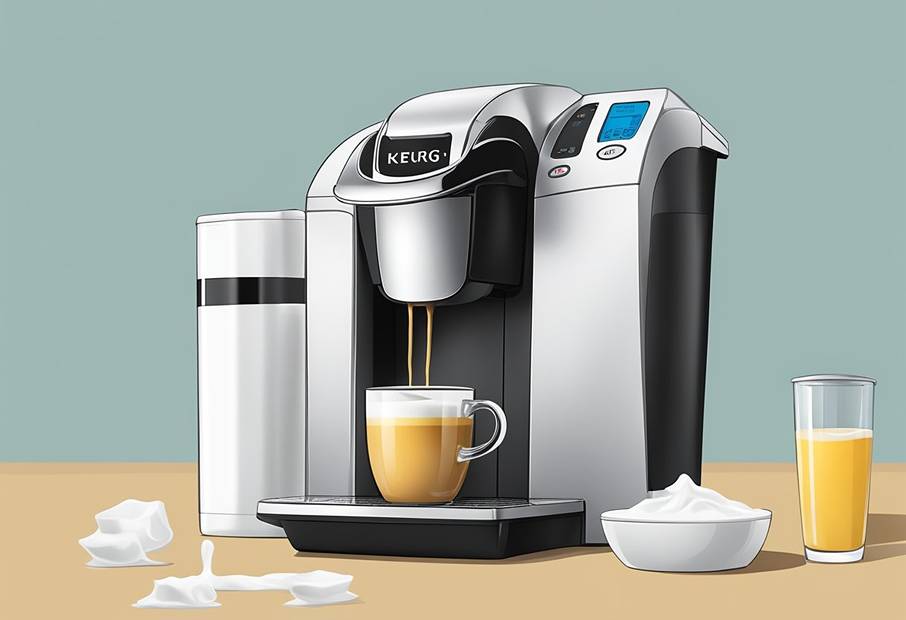
Machine Damage
Using milk in your Keurig machine can lead to significant damage.
Keurig devices are designed to handle water, which is thin and easy to move around, while milk has a thicker consistency that the machine’s mechanisms are not built to handle.
If you put milk in your Keurig, it could harm the heating elements and pumps, causing the machine to malfunction or break down entirely.
Clogging Issues
Another issue with using milk in your Keurig is the potential for clogging. Unlike water, milk contains proteins and fats that can leave residue and build-up inside your machine.
Over time, this can lead to clogs in the various components of your Keurig, such as the brewing needle and water lines.
These clogs can not only affect the consistency and taste of your coffee but also cause your machine to stop functioning correctly.
To avoid these problems, it is best to stick to using water in your Keurig and add milk separately to your coffee after brewing.
Some alternative options include using Keurig-compatible milk pods or purchasing a separate milk frother to create creamy, delicious coffee beverages.
By choosing one of these methods, you can enjoy your favorite coffee drinks without risking damage or clogs in your Keurig machine.
Alternative Ways to Add Milk To Your Coffee
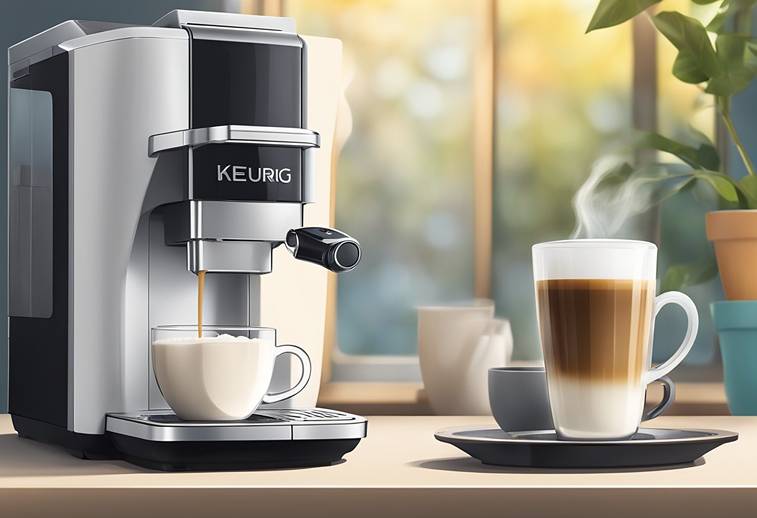
When it comes to adding milk to your coffee, putting it directly into your Keurig machine is not recommended, as it can cause damage to the device.
However, there are several alternative methods to heat and froth your milk before adding it to your coffee.
Let’s explore two options for heating your milk, using either a stovetop or a microwave, and learn about a handy accessory, the milk frother.
Stovetop Heating
A traditional way to heat milk is on your stove. First, pour your chosen type of milk—whether it’s almond milk, soy milk, or whole milk—into a small saucepan.
Place the saucepan on the stove and heat it over low to medium heat, stirring occasionally to prevent the milk from scorching or forming a skin.
Keep an eye on it and remove the saucepan from the stove once your milk reaches the desired temperature.
You can then pour it directly into your coffee or use a milk frother to create a delightful, café-quality foam.
Microwave Heating
If you prefer using a microwave to heat your milk, begin by pouring the milk of your choice into a microwave-safe container.
Then, place the container into your microwave and heat it for 30 to 45 seconds, depending on the desired temperature.
Keep in mind that every microwave is different, so it may take a bit of trial and error to achieve the perfect temperature.
After heating, you can add the milk to your coffee as is or froth it with a milk frother for a creamier texture.
Milk Frothers
Regardless of how you heat your milk, a milk frother is an excellent addition to your coffee-making arsenal.

Handheld or electric, milk frothers are designed to quickly and effortlessly create the perfect foam for lattes, cappuccinos, and other milk-based coffee drinks.
Simply submerge the frother’s whisk in the heated milk and turn it on to whip up a silky, airy foam.
In conclusion, while you should not put milk directly into your Keurig, there are various ways to heat and froth it before adding it to your coffee.
Using a stove, microwave, or milk frother, you can easily transform your favorite milk—be it almond, soy, or whole milk—into a delicious, indulgent topping for your coffee.
Cleaning Your Keurig After Using Milk
When dealing with a potential mess caused by putting milk in your Keurig, it’s essential to clean and descale your machine thoroughly to avoid any damage and clogging.
In this section, we will cover two methods to clean your Keurig: Cleaning with vinegar and Descaling with baking soda.
Cleaning With Vinegar
Step 1: First, turn off and unplug your Keurig machine. To ensure safety, remove any pods or cups that may be present.
Step 2: Disassemble the machine by removing the water reservoir, drip tray, and K-cup holder. Rinse each component with warm, soapy water and let them air dry.
Step 3: Fill the water reservoir with a 1:1 mixture of white vinegar and water up to the max fill line. Place the reservoir back in the machine and plug it in.
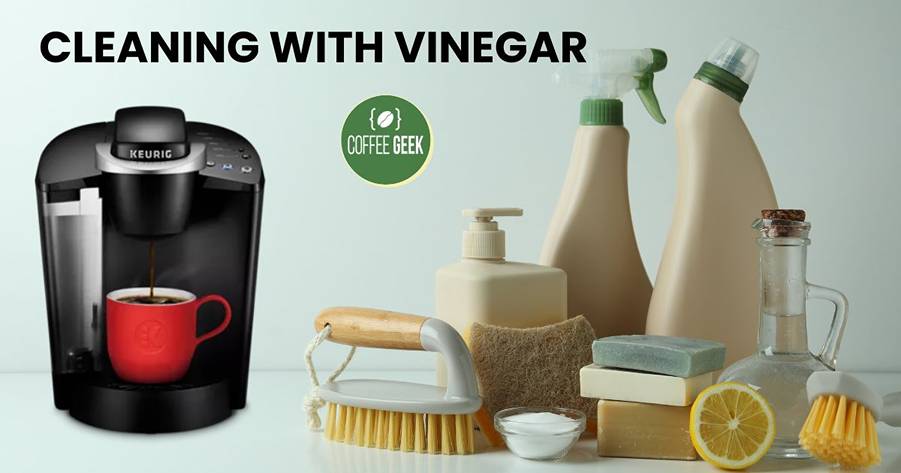
Step 4: Run a brewing cycle without inserting a K-cup. This process will help clean the interior by pushing the vinegar solution through the machine. Repeat this step until the reservoir is empty.
Step 5: Once the vinegar solution has run through the machine, fill the reservoir with clean water and run a few more brewing cycles to ensure any remaining vinegar is flushed out.
Descaling With Baking Soda
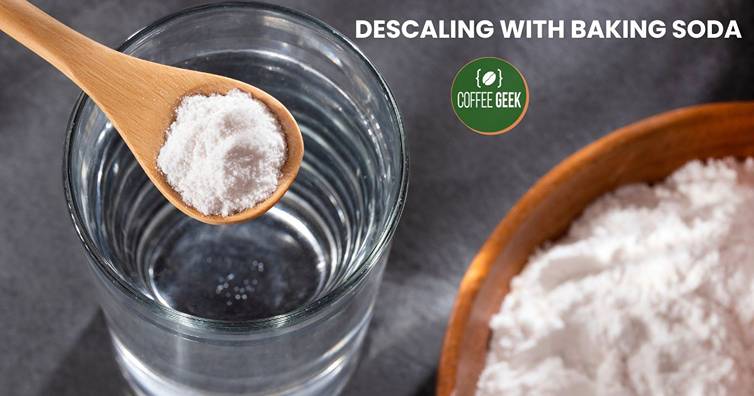
If you prefer an alternative to vinegar, you can also use baking soda to descale your Keurig.
Step 1: Unplug the machine, remove any pods or cups, and disassemble the Keurig as previously described. Clean each component with warm soapy water and let them air dry.
Step 2: Dissolve 2 tablespoons of baking soda in 1 cup of water. Pour this solution into the water reservoir, then fill the rest of the reservoir with water up to the max fill line.
Step 3: Place the reservoir back in the machine, plug it in, and run a brewing cycle without inserting a K-cup. This process will push the baking soda solution through the machine, cleaning the interior. Repeat this step until the reservoir is empty.
Step 4: Refill the water reservoir with clean water and run a few more brewing cycles to flush out any remaining baking soda solution.
By properly cleaning and descaling your Keurig after using milk, you can prevent potential clogs and damage to your machine, ensuring it continues to brew delicious coffee.
Milk-Based Drinks You Can Make With Keurig

While you cannot directly put milk in a Keurig, there are ways to make milk-based drinks using your Keurig machine. We will discuss how to prepare lattes, cappuccinos, and hot chocolates using your Keurig.
Making Lattes
To make a latte using your Keurig, follow these steps:
- Brew a strong coffee using a coffee pod of your choice.
- Heat milk separately and create froth using a milk frother or by vigorously shaking it in a closed container.
- Pour the frothy milk over your brewed coffee.
For an even simpler solution, Keurig offers milk-based K-Café pods that you can use to make lattes easily without manual frothing.
Preparing Cappuccinos
Creating cappuccinos with your Keurig is quite similar to making lattes:
- Brew a strong coffee using a dark roast coffee pod.
- Heat and froth milk separately. For cappuccinos, the froth should be thicker than for lattes.
- Gently pour the frothy milk over your coffee, maintaining a 1:1 ratio of coffee to froth.
You can find cappuccino K-Cup pods specially designed for Keurig machines to make the process even more convenient.
Creating Hot Chocolates
Hot chocolate is another popular milk-based drink that you can make with your Keurig:
- Choose a hot chocolate K-Cup pod and insert it into your Keurig machine.
- Brew the hot chocolate using the smallest cup setting for a richer flavor.
- Heat milk separately and mix it with the brewed hot chocolate concentrate.
Feel free to adjust the milk-to-hot chocolate concentrate ratio to suit your taste preference.
Enjoy your delicious homemade hot chocolate made with your Keurig!
| Aspect | Information |
|---|---|
| Can you put milk in a Keurig? | Keurig machines are designed for coffee, not milk. Adding milk directly may damage the machine and void the warranty. |
| Alternative options | Use a separate milk frother or heat milk separately before adding it to your coffee. Alternatively, consider Keurig-compatible coffee pods with milk-based options. |
| Potential issues | Putting milk in the Keurig may clog the system, affect brewing performance, and lead to hygiene concerns. |
| Maintenance concerns | Cleaning the Keurig becomes more challenging with milk residue. Regularly descale and clean the machine to prevent issues. |
| Manufacturer’s advice | Refer to the Keurig user manual or contact customer support for official guidance on using liquids other than water in the machine. |
Conclusion
When it comes to using a Keurig coffee machine, a common question that arises is whether you can put milk in a Keurig.
The straightforward answer is no; you should never put milk in the Keurig water reservoir.
Keurig machines are designed for water, not milk. Milk is thicker than water and has properties that can lead to spoilage and the formation of a hard milk crust, which can irreparably damage your Keurig.
If you’re looking to make hot cocoa or a milk-based coffee drink, like a latte, there are safer and more effective methods than pouring milk into your Keurig.
One popular way to make hot chocolate with milk is to heat the milk separately, either in a microwave or on a stove, and then add the hot cocoa mix.
Similarly, for coffee drinks, brew your regular coffee with the Keurig using water, then add heated milk to the coffee.
The Keurig K-Cafe machine is a notable exception in the Keurig line, as it comes with built-in milk frothers that allow you to froth cold milk.
This feature is particularly useful for creating drinks like lattes or cappuccinos.
However, even in this case, the milk is frothed separately and then added to the coffee; it’s not run through the machine like water.
Using milk instead of water in the water tank of any Keurig model is not recommended. Doing so not only risks damaging the machine with burned milk and spoiled milk residues but also can be difficult to clean.
Many Keurig models are designed for single-serve coffee and use pre-packaged coffee pods, which may contain dry milk for certain milk-based drinks, but still require water to operate.
In conclusion, while you can enjoy a variety of coffee or hot chocolate drinks with your Keurig, always remember to use milk separately and add it to your coffee after brewing.
This approach will ensure the longevity of your machine and the quality of your drinks
Frequently Asked Questions

Can I put milk in your Keurig coffee machine instead of water?
No, you should never put milk through your Keurig coffee maker instead of water.
It’s designed to heat water only and pumping milk through can damage the machine and build up scale and bacteria.
Instead, heat your milk separately, such as putting milk in the microwave, and add it to your coffee afterward.
What happens if I put milk in my Keurig instead?
Putting milk into a Keurig can cause significant damage to the machine.
Milk can clog the lines, creating a build-up of bacteria and eventually causing the machine to stop working. Instead, heat up your cup of milk separately and then add it to your coffee.
Can I use a Keurig to make hot milk for my coffee drink?
It’s not recommended to use a Keurig to make hot milk for your coffee drinks.
These coffee makers aren’t designed for milk, and adding milk to your Keurig water tank could lead to issues including irreparable damage to the machine.
Can I use whole milk in the keurig water tank for my coffees?
No, you should never put milk, whole or otherwise, in the Keurig water tank.
This has the potential to cause serious damage to the coffee maker. Instead, heat your whole milk separately and add it to your coffee afterwards.
Is it safe to add hot chocolate mix with milk in my Keurig coffee maker?
Yes, you can add hot chocolate mix to your Keurig, but not milk. Unlike regular coffee, hot chocolate pods usually contain dry milk powder.
However, you should not add liquid milk to the water tank. If you prefer hot milk, heat it separately, perhaps in the microwave, then mix it with your hot chocolate.
What’s the best way to make a latte with your Keurig?
Making a latte with your Keurig can be simple – brew a coffee pod as usual and while that’s brewing, heat milk in a separate cup, possibly in the microwave, until it’s hot.
Once the coffee is brewed, add the hot milk and you have your latig.
Can I make a milk-based drink with my Keurig?
Yes, you can make milk-based drinks with a Keurig, but it’s important to remember not to put milk in the water tank.
Brew a coffee or hot chocolate pod as the machine is designed for, and then add hot milk which you have warmed separately.
Do I need to clean my Keurig if I’ve accidentally put milk in it?
Yes, if you’ve accidentally put milk in a Keurig water tank, it’s important to clean it right away to prevent damage.
Refer to the manufacturer’s instructions for how to properly clean a Keurig.
Can I put milk in my Keurig to make a creamy coffee?
While creamy coffee is delicious, you should never put milk in Keurig to make it.
The machine may be damaged and it could be a health risk due to potential bacteria build up. Instead, use a Keurig-made coffee, heat milk separately, and then combine both for a creamy coffee.
Can I make a hot chocolate with milk using a Keurig?
You can make hot chocolate with a Keurig, but the milk should be added afterwards, not during the brewing process. Heating milk in a Keurig can lead to damage.
If you want to use hot milk with your hot chocolate, heat the milk separately, such as in the microwave, and add it after the hot chocolate has brewed.



